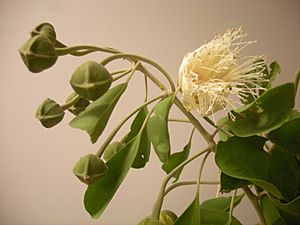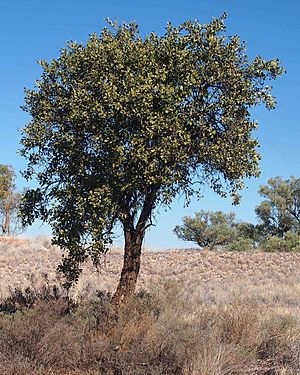Capparis mitchellii facts for kids
Quick facts for kids Capparis mitchellii |
|
|---|---|
 |
|
| Scientific classification | |
| Genus: |
Capparis
|
| Species: |
mitchellii
|
| Synonyms | |
|
|
The wild orange is a special plant that grows naturally in the dry, inland parts of Australia. Its scientific name is Capparis mitchellii. Even though it's called "wild orange," it's not related to the oranges you eat every day. Instead, it's a cousin of capers!
Long before Europeans came to Australia, Indigenous Australians used the wild orange as a food source, known as bush tucker. The fruit is full of vitamin C and can be eaten raw. People also use it in both sweet and savory dishes.
Contents
What Are Its Names?
The wild orange, Capparis mitchellii, got its scientific name from a botanist named John Lindley in the 1800s. He named it after the Scottish explorer Thomas Mitchell.
This plant has many other common names too, like the native orange, native pomegranate, and bumble tree. Indigenous Australians have their own names for it:
- In the Arrernte language from Central Australia, it's called merne atwakeye, which means bush orange.
- The Adnyamathanha language from the Flinders Ranges in South Australia calls it iga or iga warta.
- In the Gamilaraay language, it's known as bambul.
Where Does the Wild Orange Grow?
The wild orange can grow quite tall, up to eight metres (about 26 feet) high. It can be a tall bush or a small tree. Its leaves are dull green and shaped like ovals, usually between two and six centimetres long. The bark is black and has deep grooves. When the plant is young, it's very thorny!
The flowers of the wild orange are large and beautiful, usually white or cream-colored. They have long parts sticking out called stamens. But these lovely flowers only last for one day!
You can find wild oranges growing in open savannah areas, especially in the drier parts of Australia. They are common in inland eastern New South Wales and Queensland, and in the southern Northern Territory. They like sandy or clay soils but can also grow on rocky hillsides and in areas with limestone.
In the Flinders Ranges of South Australia, the Adnyamathanha people use this plant. There's even a cultural tourism place called Iga Warta, named after the local word for the wild orange.
What About the Fruit?
The wild orange fruit is a delicious part of bush tucker. Indigenous Australians have been eating it for a very long time.
When the fruit is unripe, it's round and green. As it ripens in mid to late summer, it turns a shade of purple or orange and becomes soft. It also develops a sweet smell. A ripe wild orange fruit is usually 4–7cm (about 1.5 to 2.7 inches) across.
The raw fruit is a great source of Vitamin C and has a pleasant, slightly tangy taste. You can't eat the seeds or the skin, but the soft inside part is good! People eat it raw, or use it to make desserts, cordial (a type of drink), or add it to main meals.
Pests That Like Wild Orange
Sometimes, the wild orange fruit gets tiny visitors: caper white butterfly larvae (which are caterpillars). These caterpillars love to eat the fruit. The wild orange is also a favorite food for the spotted bowerbird.
Images for kids
See also
 In Spanish: Naranja australiana para niños
In Spanish: Naranja australiana para niños



